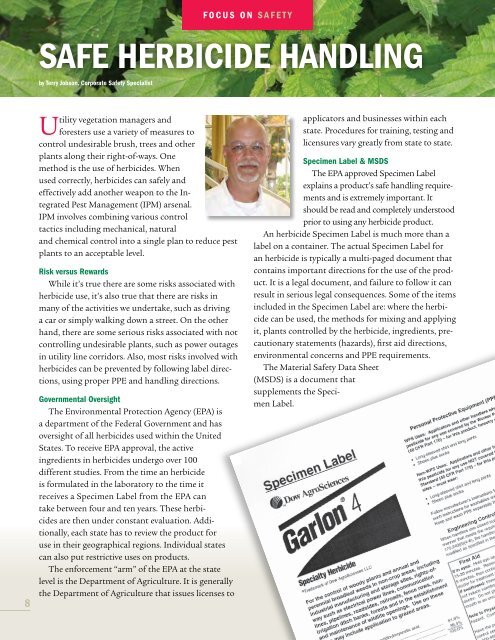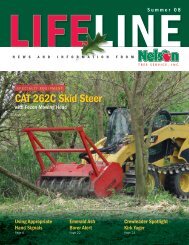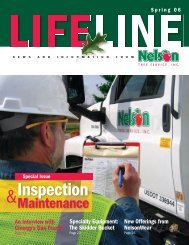LIFELINE
Winter 08 - Nelson Tree Service
Winter 08 - Nelson Tree Service
You also want an ePaper? Increase the reach of your titles
YUMPU automatically turns print PDFs into web optimized ePapers that Google loves.
F O C U S O N S A F E T Y<br />
SAFE HERBICIDE HANDLING<br />
by Terry Jobson, Corporate Safety Specialist<br />
8<br />
Utility vegetation managers and<br />
foresters use a variety of measures to<br />
control undesirable brush, trees and other<br />
plants along their right-of-ways. One<br />
method is the use of herbicides. When<br />
used correctly, herbicides can safely and<br />
effectively add another weapon to the Integrated<br />
Pest Management (IPM) arsenal.<br />
IPM involves combining various control<br />
tactics including mechanical, natural<br />
and chemical control into a single plan to reduce pest<br />
plants to an acceptable level.<br />
Risk versus Rewards<br />
While it’s true there are some risks associated with<br />
herbicide use, it’s also true that there are risks in<br />
many of the activities we undertake, such as driving<br />
a car or simply walking down a street. On the other<br />
hand, there are some serious risks associated with not<br />
controlling undesirable plants, such as power outages<br />
in utility line corridors. Also, most risks involved with<br />
herbicides can be prevented by following label directions,<br />
using proper PPE and handling directions.<br />
Governmental Oversight<br />
The Environmental Protection Agency (EPA) is<br />
a department of the Federal Government and has<br />
oversight of all herbicides used within the United<br />
States. To receive EPA approval, the active<br />
ingredients in herbicides undergo over 100<br />
different studies. From the time an herbicide<br />
is formulated in the laboratory to the time it<br />
receives a Specimen Label from the EPA can<br />
take between four and ten years. These herbicides<br />
are then under constant evaluation. Additionally,<br />
each state has to review the product for<br />
use in their geographical regions. Individual states<br />
can also put restrictive uses on products.<br />
The enforcement “arm” of the EPA at the state<br />
level is the Department of Agriculture. It is generally<br />
the Department of Agriculture that issues licenses to<br />
applicators and businesses within each<br />
state. Procedures for training, testing and<br />
licensures vary greatly from state to state.<br />
Specimen Label & MSDS<br />
The EPA approved Specimen Label<br />
explains a product’s safe handling requirements<br />
and is extremely important. It<br />
should be read and completely understood<br />
prior to using any herbicide product.<br />
An herbicide Specimen Label is much more than a<br />
label on a container. The actual Specimen Label for<br />
an herbicide is typically a multi-paged document that<br />
contains important directions for the use of the product.<br />
It is a legal document, and failure to follow it can<br />
result in serious legal consequences. Some of the items<br />
included in the Specimen Label are: where the herbicide<br />
can be used, the methods for mixing and applying<br />
it, plants controlled by the herbicide, ingredients, precautionary<br />
statements (hazards), first aid directions,<br />
environmental concerns and PPE requirements.<br />
The Material Safety Data Sheet<br />
(MSDS) is a document that<br />
supplements the Specimen<br />
Label.








